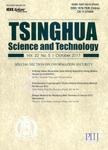Affinity Solvents for Intensified Organics Extraction: Development Challenges and Prospects
Affinity Solvents for Intensified Organics Extraction: Development Challenges and Prospects作者机构:University of Twente Enschede The Netherlands
出 版 物:《Tsinghua Science and Technology》 (清华大学学报(自然科学版(英文版))
年 卷 期:2006年第11卷第2期
页 面:171-180页
核心收录:
学科分类:08[工学] 0806[工学-冶金工程] 080601[工学-冶金物理化学]
主 题:affinity solvent organics extraction molecular recognition complexation reaction
摘 要:In most organics extraction processes, the commonly used solvents employ solely physical interactions. Therefore, for the recovery and purification of products from complex mixtures, the selectivity and/or capacity of classical solvents towards the desired solutes is usually insufficient, enforcing the need for complex and thus expensive separation schemes. Significant simplification and cost-reduction can be achieved when affinity solvents would be available that are able to recognize the solutes of interest by their molecular structure. The main development challenges to establish such affinity solvents are: Selection and incorporation of molecular recognition and complexation capabilities; Evaluation of extraction capabilities; Efficient re- covery and recycling of the affinity solvents; Implementation in industrial extraction equipment. This paper presents how these development challenges are addressed at the University of Twente, going all the way from affinity solvent design and synthesis, via high throughput screening and characterization up to pilot plant evaluation. Essential in the successful development of affinity solvents are structural cooperations with molecular chemists and custom synthesis companies for their design and synthesis. The various aspects are illustrated by several examples where newly developed environmentally benign affinity solvents appeared able to create major breakthroughs. The applications addressed involve oxygenates, sugars, and pharmaceutical ingredients, such as optical isomers and biomolecules.



